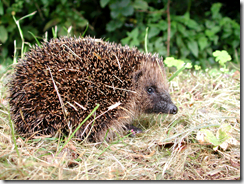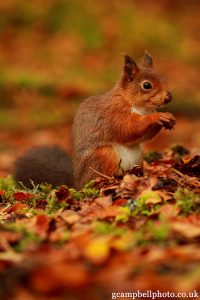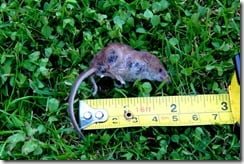 Reports suggest that the earliest record of hedgehogs in Ireland stem from County Waterford at around the time that the Normans arrived in the 13th century. However and whenever these endearing little mammals arrived they have certainly become a firmly established native and something of a favourite with people.
Reports suggest that the earliest record of hedgehogs in Ireland stem from County Waterford at around the time that the Normans arrived in the 13th century. However and whenever these endearing little mammals arrived they have certainly become a firmly established native and something of a favourite with people.
Hedgehogs are 15-30 cm (6-12 inches) long and weigh between 1.5 and 2 kilos (3.5 and 4.5 lb). Their back is covered with five thousand or more short, yellow-tipped spines with brown fur covering the rest of the body. Strong muscles along their backs allow hedgehogs to curl into a tight ball when threatened, relying on their spines to protect their vulnerable head and underside.
The common name, “hedgehog” comes from their pig-like habit of rooting around in the undergrowth for food. They are quite vocal, and can be heard grunting and snuffling loudly as they forage for slugs, snails, beetles and earthworms.
Hedgehogs are solitary, non-territorial animals that are mainly active at night, particularly after a heavy rainfall when they can find their prey more readily. They have poor eyesight but a keen sense of smell and excellent hearing, both of which help them to locate food.
In spring and early summer female hedgehogs give birth to one or two litters of up to five young. At first baby hedgehogs rely exclusively on their mother’s milk, but start taking solid food after about three weeks. They are fully weaned at around five weeks old.
During the summer hedgehogs sleep by day in a temporary nest of leaves, moss and grass – emerging as the light fades to feed voraciously. By autumn they will have packed on a considerable amount of weight ready for hibernation during the winter months.
The hibernation nest is usually built under a hedge, in an old rabbit burrow or even at the base of a garden compost heap. Hedgehogs carry nesting material to their chosen site and, once they have made a big enough mound, burrow into the centre and make a cosy bed to sleep away the winter.
Hibernation normally takes place between November and March or April, depending on the prevailing weather conditions. During hibernation a hedgehog’s heart-rate falls dramatically: from some 190 beats per minute down to about 20. The animal’s core body temperature also drops, and can get as low as 10 degrees Celsius (50 degrees Fahrenheit). It is this hibernation period that accounts for most hedgehog deaths, with an estimated 75% of juvenille hedgehogs never waking from their first winter’s sleep.
Hedgehogs can live for up to five years, but few reach this age in the wild. While curling into a spiny ball provides admirable protection from natural dangers – the badger is the only native Irish animal capable of prising open and killing a hedgehog – it offers scant protection against man-made threats.
Principal among these, of course, is traffic: thousands of hedgehogs are killed every year on our roads. Other prevalent man-made killers are lawnmowers and strimmers. Most animals flee to safety at the approach of these mechanical killers, but hedgehogs rely on their natural defence and simply curl into a ball and wait – with inevitably fatal results.
Taking refuge in bonfires is another common cause of hedgehog death. To them, an unlit bonfire is similar to their hedgerow habitat, and many are unwittingly burnt every year. Still more are drowned when they fall into steep-sided ornamental ponds or water-features while taking a drink.
Despite high mortality rates hedgehogs are still relatively common, and if you venture into the countryside after dark sooner or later you will probably hear the rustles, grunts and snuffles of their foraging. If you’re lucky you may even catch a glimpse of one as it searches through the undergrowth for its next meal.










2 comments
Gerry
Thanks for the info. I have two small mounds beneath a hedgerow in the garden. For the last few years around end July and August, there is a very strong odour coming from the hedge – could they be hedgehog nests? Thanks. Gerry